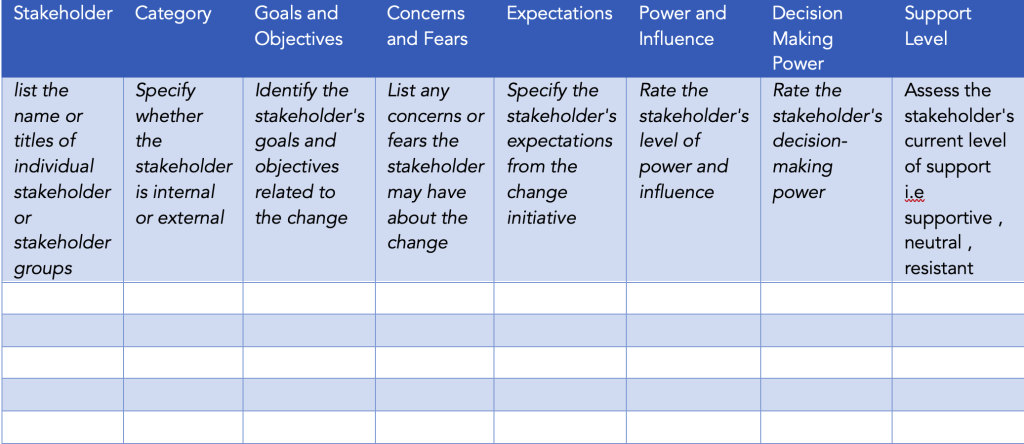Embarking on a journey of change within an organization is like setting sail into uncharted waters.
In the vast sea of transformation, navigating the waves of transition requires a compass, and that compass is none other than a meticulous and insightful stakeholder analysis for change management.
Imagine stakeholders as the guiding stars in this navigational process, each with its own unique brilliance shaping the course of organizational evolution.
In this blog post, we’ll embark on an exploration of the transformative power of stakeholder analysis and uncover its vital role in change management.
From understanding the intricacies of stakeholder dynamics to wielding the tools that facilitate smooth sailing, we’ll delve into the why, the how, and the real-world impact of this indispensable practice.
What is Change Management?
Change management refers to the structured approach and set of tools and techniques employed to lead individuals, teams, and organizations through a period of transition.
The ultimate goal of change management is to help organizations implement changes smoothly and effectively to achieve desired outcomes.
These changes could be related to processes, technologies, organizational structure, culture, or any other aspect of the business.
Change management involves understanding the human side of change, anticipating potential resistance, and implementing strategies to minimize disruptions and enhance the likelihood of success.
It encompasses a range of activities, including communication, training, and providing support to employees and stakeholders affected by the change.
Who are stakeholders?
Stakeholders are individuals, groups, or entities that have an interest or concern in the activities and outcomes of an organization.
Essentially, stakeholders are anyone who can affect or be affected by an organization’s actions, policies, or objectives.
What is stakeholder analysis for change management?
Stakeholder analysis for change management is a systematic process of identifying, analyzing, and managing the individuals and groups who may be impacted by a change initiative.
The primary objectives of stakeholder analysis in the context of change management include understanding the needs, interests, and concerns of various stakeholders, assessing their influence and level of support, and developing strategies to engage and communicate with them effectively.
Why use of Stakeholder Analysis in Organizational Change Management is Important?
Here are key reasons why use of stakeholder analysis in organizational change management is important:
Identification of Key Players
Stakeholder analysis helps identify and categorize stakeholders based on their influence and interest in the change. This identification is crucial for determining who should be involved in the change process and to what extent.
Managing Resistance
Understanding the concerns and potential resistance of stakeholders allows change managers to proactively address issues and design strategies to mitigate resistance. This can prevent roadblocks and increase the likelihood of successful change implementation.
Effective Communication
Stakeholder analysis provides insights into the communication preferences of different stakeholders. It helps tailor communication strategies to ensure that information about the change is disseminated in a way that resonates with and engages the intended audience.
Resource Allocation
By assessing the influence and importance of each stakeholder, organizations can allocate resources more effectively. This includes determining where to focus efforts for maximum impact and where additional support or attention may be necessary.
Building Support and Collaboration
Engaging stakeholders throughout the change process builds trust, fosters collaboration, and increases the likelihood of obtaining support for the change. This is crucial for overcoming challenges and ensuring a smoother transition.
Risk Management
Identifying potential risks associated with stakeholders and their reactions allows organizations to develop contingency plans. This proactive approach helps in minimizing the negative impact of unforeseen challenges.
Essentials Steps to Conducting Stakeholder Analysis for Change Management
Here are the essential steps to conducting stakeholder analysis for change management.
1. Identifying Stakeholders
Identifying both internal and external stakeholders is paramount in any organizational initiative because it ensures a comprehensive understanding of the diverse web of individuals and entities that can influence or be impacted by a change.
Internal stakeholders, such as employees and management, hold intricate knowledge of the organization’s inner workings and can significantly influence the success of a change initiative.
On the other hand, external stakeholders, including customers, suppliers, and regulatory bodies, bring external perspectives, market dynamics, and compliance considerations into the equation.
Recognizing and engaging with both internal and external stakeholders enables organizations to build a holistic strategy, addressing a wide range of interests, concerns, and expectations.
Given below are some key stakeholders in an organization and few considerations are also mentioned that need to be taken into account while identifying stakeholders.
Employees
Identify all levels of employees, from front-line staff to upper management.
Consider different departments and teams within the organization.
Management
Identify top-level executives, middle management, and supervisors.
Understand the priorities and concerns of each management level.
Customers
Segment customers based on demographics, preferences, and buying behavior.
Identify long-term and high-value customers.
Suppliers
Identify key suppliers and partners in the supply chain.
Assess the impact of the change on the relationships with suppliers.
Regulatory Bodies
Identify relevant government agencies and industry regulatory bodies.
Understand the regulatory requirements and compliance expectations.
2. Assessing Stakeholder Interests
Assessing stakeholders’ interests is crucial in change management because it provides a deep understanding of what motivates and concerns individuals or groups affected by a change initiative.
By comprehensively evaluating stakeholders’ goals, expectations, concerns, and expectations, organizations can tailor their strategies to align with these interests, increasing the likelihood of stakeholder support and reducing resistance.
This insight allows for the identification of potential challenges and the development of targeted communication and engagement plans, ensuring that the change initiative addresses stakeholders’ needs.
When assessing stakeholders’ interests, it’s important to consider a range of factors that can influence their perspectives, concerns, and expectations. Key areas to assess include:
Goals and Objectives
Identify stakeholders’ individual and organizational goals related to the change.
Understand what they aim to achieve through the initiative.
Concerns and Fears
Explore any apprehensions or fears stakeholders may have about the change.
Uncover potential obstacles or challenges that could impede their support.
Expectations
Determine the specific outcomes or results stakeholders expect from the change.
Clarify what success looks like from their perspective.
Values and Priorities
Understand the values and priorities that guide stakeholders’ decision-making.
Recognize what is most important to them in the context of the change.
Impact on Roles and Responsibilities
Assess how the change may affect stakeholders’ roles, responsibilities, and daily tasks.
Recognize changes in job functions or team dynamics.
Communication Preferences
Identify how stakeholders prefer to receive information about the change.
Tailor communication strategies to align with their preferred channels and styles.
Level of Influence
Determine the level of influence stakeholders have within the organization.
Understand who holds decision-making authority and who can sway opinions.
Historical Context
Consider past experiences with organizational changes.
Assess how previous initiatives may influence stakeholders’ current perspectives.
Cultural and Social Factors
Recognize cultural and social influences that may shape stakeholders’ views.
Consider diversity, inclusion, and cultural nuances in the assessment.
Economic Considerations
Explore how the change may impact stakeholders economically.
Consider factors such as job security, financial incentives, or cost implications.
3. Analyzing Stakeholder Influence
By delving into power dynamics and decision-making authority, organizations can tailor their strategies to engage effectively with stakeholders who have the greatest influence on the success of the change initiative.
This knowledge is instrumental in determining the best approaches for gaining support, addressing concerns, and navigating the intricate landscape of stakeholder relationships during the change management process.
Power Dynamics
Determine who holds significant power within the organization or the stakeholder group.
Consider formal positions, expertise, networks, and personal influence.
Understand the sources of power, such as expertise, position, control of resources, or personal relationships.
Differentiate between legitimate, referent, expert, reward, and coercive power.
Decision-Making Authority
Determine who has the authority to make decisions related to the change.
Consider formal decision-making structures and informal influencers.
Analyze the organization’s decision-making processes.
Identify the stages, key decision points, and those involved at each level.
Assess the decision-making styles of key stakeholders.
Some may prefer a collaborative approach, while others may be more autocratic.
4. Creating a Stakeholder Matrix
List all identified stakeholders from the previous steps.
Include both internal and external stakeholders, considering employees, management, customers, suppliers, regulatory bodies, and any other relevant groups.
Define criteria for assessing stakeholders. This can include influence, interest, power, support level, or any other relevant factors based on the goals of your change initiative.
Evaluate each stakeholder against the chosen criteria.
Use a scale (e.g., low, medium, high) to rate their level of influence, interest, or other relevant attributes.
Create a table with stakeholders listed on one axis (rows) and the chosen criteria on the other axis (columns).
Populate the matrix with the assessed ratings for each stakeholder.
| Stakeholder | Influence | Interest | Power | Support Level |
| Employee A | High | Medium | Low | Supportive |
| Manager B | Medium | High | High | Neutral |
| Customer C | Low | High | Low | Supportive |
| Supplier D | High | Low | Medium | Resistant |
| Regulatory Body E | High | Low | High | Neutral |
Interpret the matrix to identify patterns and insights.
Pay attention to stakeholders with high influence but low support or those with high power but low interest.
Use color-coding or symbols to highlight critical stakeholders or those requiring specific attention.
Stakeholder Analysis Change Management Example
Let’s consider a real-life stakeholder analysis change management example within a large technology company that is undergoing a significant digital transformation initiative.
Scenario: Digital Transformation in a Technology Company
Step 1. Identifying Stakeholders
Employees: Include software developers, project managers, marketing teams, and administrative staff.
Management: Encompasses top-level executives, middle managers, and team leaders.
Customers: Both individual consumers and corporate clients who use the company’s products and services.
Suppliers: Key technology providers and service partners.
Regulatory Bodies: Government agencies overseeing data protection and industry regulations.
Step 2. Assessing Stakeholder Interests
Goals and Objectives: Employees aim for streamlined processes, improved collaboration, and career growth. Management seeks increased efficiency and profitability.
Customers desire user-friendly products. Suppliers aim for continued partnerships. Regulatory bodies are concerned with compliance.
Concerns and Fears: Employees fear job redundancies and adapting to new technologies. Management is concerned about project timelines and potential resistance.
Customers worry about service disruptions. Suppliers fear changes affecting their contracts. Regulatory bodies are concerned about data security during the transformation.
Step 3. Analyzing Stakeholder Influence
Power Dynamics: Top executives hold significant power due to their decision-making authority. Key software developers have high influence due to their expertise. Regulatory bodies have substantial power in enforcing compliance.
Decision-Making Authority: Top management has the ultimate decision-making authority, but input is also sought from key department heads and senior developers.
Step 4. Creating a Stakeholder Matrix
| Stakeholder | Influence | Interest | Power | Support Level |
| Lead Developer A | High | High | Medium | Supportive |
| CFO B | High | Medium | High | Neutral |
| Customer C | Low | High | Low | Supportive |
| Technology Partner D | High | Low | High | Resistant |
| Regulatory Body E | High | Low | High | Neutral |
Change Management Stakeholder Analysis Template
Below is a simple change management stakeholder analysis template that you can use as a starting point. This template includes key elements for identifying, assessing, and managing stakeholders throughout the change management process

Challenges and Solutions in Stakeholder Analysis
Below are the most common challenges and their solution in stakeholder analysis for change management.
A. Overlooking Key Stakeholders
Challenges
Identifying all relevant stakeholders can be challenging, leading to the oversight of key individuals or groups.
Failure to include important stakeholders may result in unanticipated resistance or lack of support.
Solutions
Comprehensive Stakeholder Mapping:
Conduct thorough stakeholder mapping for change management and analysis to identify all potential stakeholders.
Utilize tools such as surveys, interviews, and workshops to gather diverse perspectives.
Stakeholder Input:
Seek input from different departments, teams, and levels within the organization.
Encourage employees to identify and communicate the presence of overlooked stakeholders.
Regular Reviews:
Conduct periodic reviews of the stakeholder list to account for changes in the organizational landscape.
Incorporate feedback and updates from ongoing stakeholder engagement activities.
B. Balancing Conflicting Interests:
Challenges
Stakeholders may have divergent interests, creating conflicts that can impede the change process.
Balancing conflicting interests requires careful navigation to ensure a harmonious transition.
Solutions
Facilitated Discussions:
Organize facilitated discussions or workshops to allow stakeholders to express their concerns and interests.
Seek common ground and areas of compromise through open dialogue.
Mediation:
Introduce a neutral mediator or facilitator to help resolve conflicts and find mutually agreeable solutions.
Encourage stakeholders to focus on shared organizational goals rather than individual interests.
Clear Communication:
Communicate openly about the reasons for the change and how it aligns with the overall organizational strategy.
Emphasize the shared benefits of the change to mitigate conflicting interests.
C. Adapting to Changing Stakeholder Dynamics:
Challenges
Stakeholder dynamics can evolve over time due to organizational changes, external factors, or shifting priorities.
Failure to adapt to changing dynamics can lead to outdated strategies and ineffective stakeholder management.
Solutions
Continuous Monitoring:
Implement a system for continuous monitoring of stakeholder dynamics.
Regularly reassess the stakeholder landscape to identify shifts in interests, power, or influence.
Feedback Mechanisms:
Establish feedback mechanisms to capture stakeholder input on an ongoing basis.
Actively seek input through surveys, suggestion boxes, or regular check-ins to stay informed.
Agile Strategies:
Adopt agile strategies that allow for flexibility in stakeholder engagement and management.
Be prepared to adjust communication plans, engagement activities, and mitigation strategies in response to changing dynamics.
Tools and Techniques for Stakeholder Analysis
There are some tools and techniques that are essential for conducting a thorough stakeholder analysis in change management.
The combination of visual mapping, direct feedback through surveys and interviews, and social network analysis provides a comprehensive understanding of stakeholder dynamics, facilitating more informed and effective decision-making during change initiatives.
A. Stakeholder Mapping Tools
Description
Stakeholder mapping tools are visual aids that help organizations represent and analyze the relationships between different stakeholders. These tools often take the form of matrices or diagrams, where stakeholders are plotted based on their level of influence and interest or other relevant criteria.
Advantages
- Provides a clear visual representation of stakeholder relationships.
- Enables easy analysis of stakeholder dynamics, allowing for strategic decision-making.
- Helps identify key stakeholders and their positions in relation to the change initiative.
B. Surveys and Interviews
Description
Surveys and interviews are data-gathering techniques used to collect qualitative and quantitative information directly from stakeholders. Surveys typically involve structured questionnaires, while interviews allow for more in-depth, open-ended discussions.
Advantages
- Provides in-depth insights into stakeholder perspectives, concerns, and expectations.
- Surveys can generate quantitative data for statistical analysis.
- Interviews allow for a personal connection, fostering trust and openness.
C. Social Network Analysis
Description
Social network analysis involves mapping and analyzing the relationships and interactions between stakeholders within an organization. It explores how information and influence flow through social networks.
Advantages
- Helps identify key influencers and opinion leaders within the organization.
- Reveals how information flows through the organization’s informal networks.
- Allows for targeted engagement with influential stakeholders to enhance change management efforts.
Final Words
As we embark on the journey of change, remember: it’s not just about managing the change but it’s about steering it with those who matter most—our stakeholders. This underscores the significance of stakeholders in change management. To navigate this transformative journey successfully, it is imperative to conduct a thorough stakeholder analysis before engaging with them. By systematically analyzing the influence and power dynamics of stakeholders, we pave the way for effective and successful engagement. This structured approach ensures that we steer the course of change with insight, responsiveness, and the support of those integral to its success.



